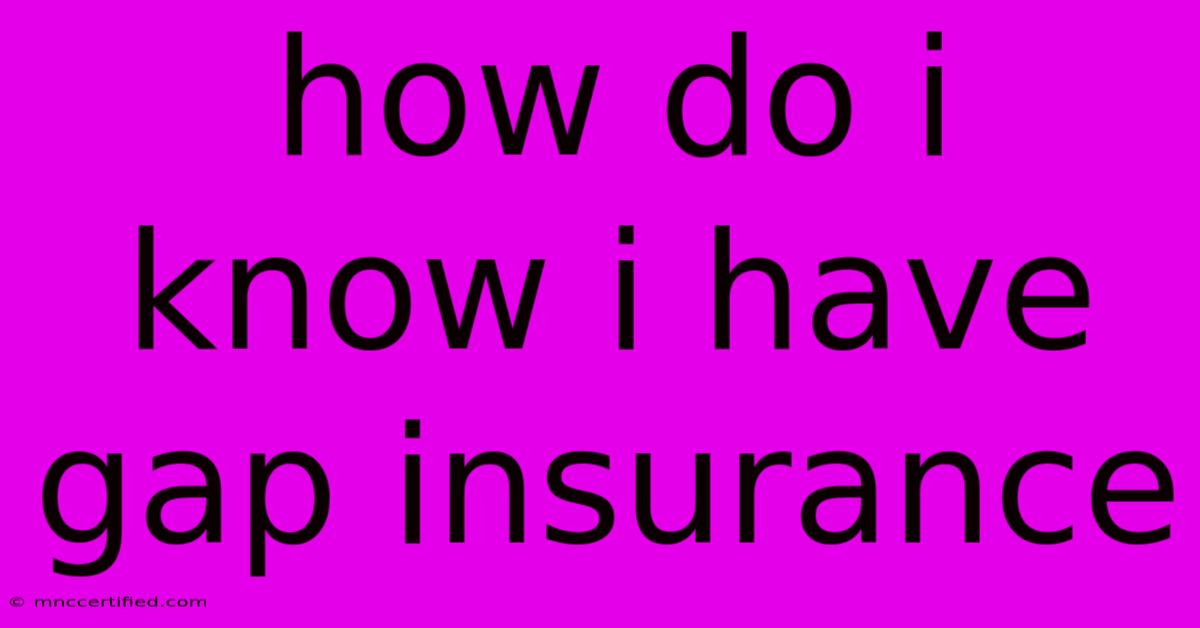How Do I Know I Have Gap Insurance

Table of Contents
How Do I Know I Have Gap Insurance? A Comprehensive Guide
Knowing whether you have gap insurance can save you thousands of dollars if your vehicle is totaled. This comprehensive guide will help you understand what gap insurance is, how to confirm you have it, and what to do if you don't.
What is Gap Insurance?
Gap insurance, or Guaranteed Asset Protection (GAP), covers the difference between what your auto loan or lease is worth and what your insurance company pays out after an accident or theft that totals your vehicle. This difference is often significant, especially in the first few years of ownership when depreciation is high. Without gap insurance, you're responsible for paying this difference out-of-pocket.
Key Situations Where Gap Insurance is Crucial:
- New Car Purchase: New cars depreciate rapidly, meaning the value drops substantially soon after purchase.
- Long Loan Terms: Longer loan terms increase the likelihood of owing more on your loan than the vehicle is worth.
- Leases: Leases often have a significant residual value that you're responsible for if the vehicle is totaled.
How to Confirm You Have Gap Insurance
There are several ways to verify if you have gap insurance coverage:
1. Check Your Insurance Policy Documents
The most reliable way to confirm coverage is to review your auto insurance policy documents. Look for sections specifically mentioning "gap insurance," "Guaranteed Asset Protection," or similar terms. Pay close attention to:
- Coverage details: The policy should outline the extent of the coverage, including any limitations or exclusions.
- Policy number: Keep a copy of your policy for easy reference.
- Expiration date: Ensure your coverage is still active.
2. Contact Your Insurance Provider
If you can't locate your policy documents, contact your insurance company directly. They can confirm whether you have gap insurance and provide you with details of your coverage. Have your policy number ready to expedite the process.
3. Review Your Loan or Lease Agreement
Your loan or lease agreement might mention whether gap insurance was included as part of the financing package. Carefully review the terms and conditions for any references to gap insurance or similar coverage. Sometimes the dealership adds this as an add-on, and the documentation will reflect that.
4. Check Your Bank or Lender Statements
If you financed your vehicle, examine your bank or lender statements for any payments related to gap insurance. This might be a separate premium or bundled into your monthly payment.
What if I Don't Have Gap Insurance?
If you discover you don't have gap insurance and your vehicle is totaled, don't panic. You still have options:
- Contact your lender: Explain the situation and explore potential solutions. They may be willing to work with you.
- Consider purchasing gap insurance: You may still be able to purchase gap insurance, though it might be more expensive after the fact.
- Explore other financial options: Look into personal loans or other financial resources to cover the shortfall.
Proactive Steps for Gap Insurance
- Read your policy carefully: Understand the terms, conditions, and limitations of your coverage.
- Keep your policy documents: Store them securely in a readily accessible location, both physical and digital.
- Review your coverage regularly: Ensure your coverage remains valid and aligns with your needs.
- Ask questions: Don't hesitate to contact your insurance provider or lender if you have any questions or concerns.
Understanding your gap insurance coverage is crucial for protecting yourself financially in the event of a total loss. By following the steps outlined above, you can confirm your coverage and take appropriate action if necessary. Remember, proactive planning and awareness can prevent significant financial hardship.

Thank you for visiting our website wich cover about How Do I Know I Have Gap Insurance. We hope the information provided has been useful to you. Feel free to contact us if you have any questions or need further assistance. See you next time and dont miss to bookmark.
Featured Posts
-
Dcd Financial And Insurance Services
Nov 16, 2024
-
Portugal Urgent Action On Foreign Bribery
Nov 16, 2024
-
Commercial Insurance For Limousine
Nov 16, 2024
-
Salvage Title Motorcycle Insurance
Nov 16, 2024
-
How To Stream Big Brother Uk Season 21 Finale
Nov 16, 2024